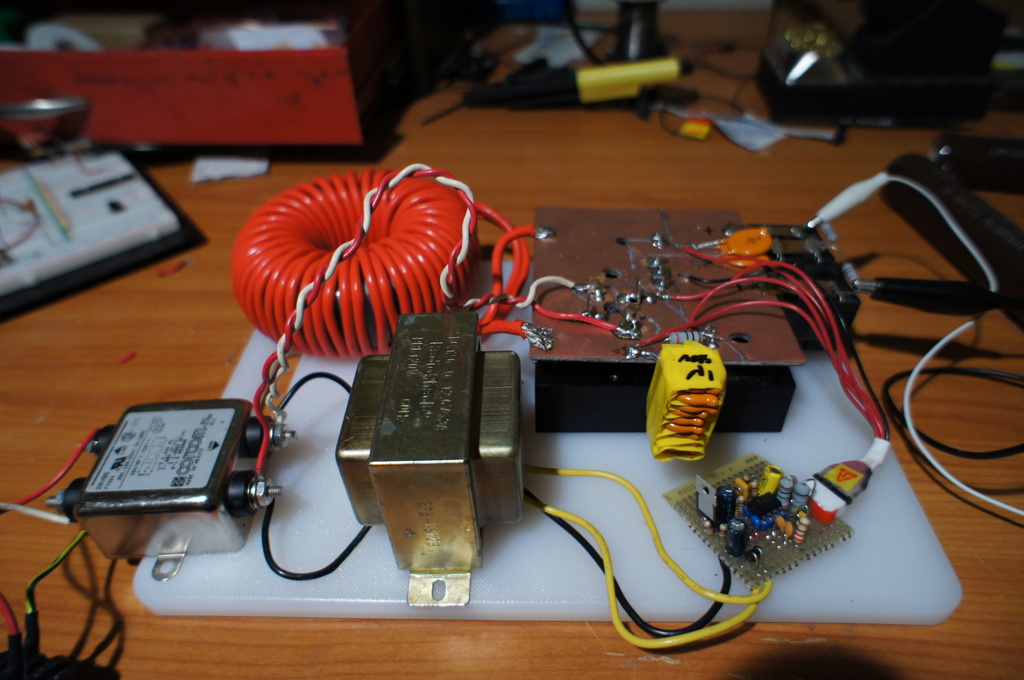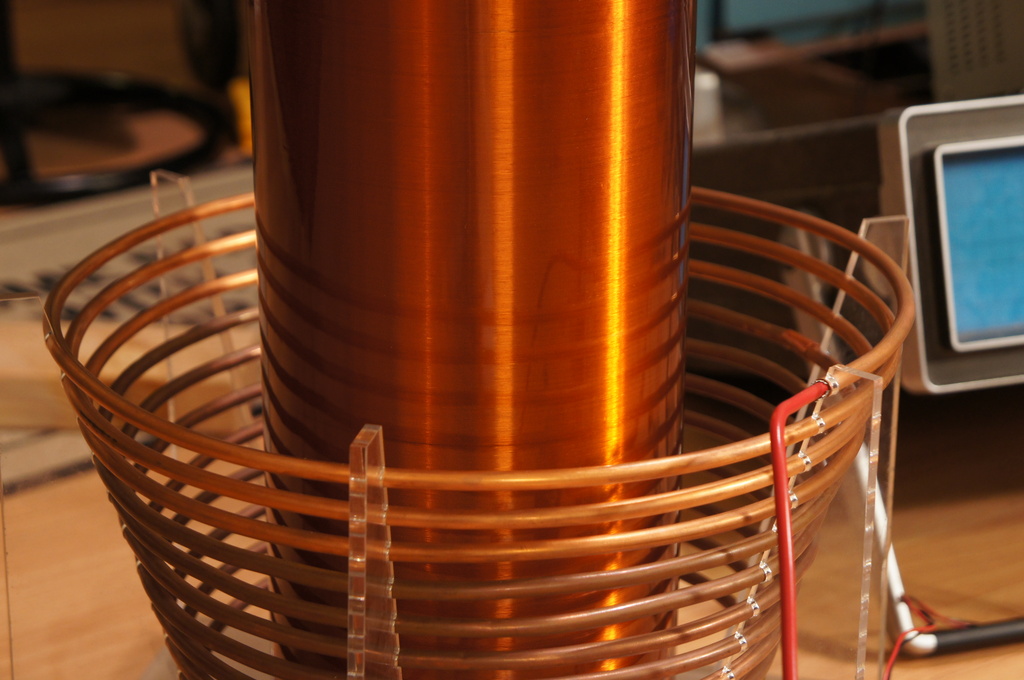Table of Contents
Solid State Tesla Coil, mk.II
Sometime in November of 2011, Chris Lu, Jacob Potter and I decided that we should have a good household project – and what better of an idea than to build a successor to Chris's original PlasmaSonic II-driven Solid State Tesla Coil (SSTC)? So, we embarked on designing a coil under the parameter of being just a good, solid, durable SSTC. We weren't looking for the biggest TC out there (we couldn't power it), or to get the longest sparks, or the highest power, but just simply a nice solid simple SSTC.
We decided that our methodology would be to build a system that was more-or-less universal, so that we could design the drive circuitry without worrying about what we'd load it with; we not-so-fondly recalled the days of having to manually tweak pots for the best sparks, and blowing up FETs with a system that's out of tune, so we decided to design a system that would be self-tuning. We also wanted to be able to experiment with emulating the nice sword-like sparks that vacuum tube Tesla coils (VTTCs) made, so we decided to design to be able to actively wave-shape; as an added bonus, this would allow us to build an interrupter “for free”, and also get audio modulation “for free”.
On this page, I describe the basic design, and provide some level of added detail for the implementation.
Quick Links
If you're looking for something specific, try one of these links:
- ...
System design
We decided that for this system, we could easily separate the work into three stages: the power input stage, the wave-shaping stage, and the drive stage. Each of these can be more or less tested in isolation, and each can work independently; the design parameters for each stage is to work as part of the whole system, but in keeping with the design philosophy of a robust, durable system, they will also work in a wide range of other conditions.
Notable about this is that in some designs, only the drive stage actually exists; the power input stage may just be implemented as a bridge rectifier and capacitor tank, if even that. Similarly, the wave-shaping stage in many other designs seems to be just an interrupter (with the notable exception of more recent QCW DRSSTCs). In our setup, however, each stage is independently designed, and each is about equally complex; in a sense, though, we designed them to be almost elegant in how simple they can be for what they do.
Input stage: PFC
 We chose a power factor correction boost circuit as a basic design for our input stage. The PFC circuit provides a few advantages:
We chose a power factor correction boost circuit as a basic design for our input stage. The PFC circuit provides a few advantages:
- Higher rail voltage. In the US, rectifying 120V mains will result in only 170V on the rails. SSTCs tend to perform better given higher voltage; the PFC design that we've chosen gives 350V on the rails (limited only by the expense of the switching components that we chose).
- Better rail stability. A standard bridge rectifier / capacitor setup will result in quite a bit of cycle-to-cycle ripple. PFC circuits maintain at least some limited input into the capacitor throughout the line cycle, allowing for a smaller capacitor (and hence less energy stored to go into detonating a shorted FET).
- And, of course, better power factor. Since we live in California, it seems only logical to have a green Tesla coil. Combined with a line filter, even though we'll be making plenty of RF noise nearby, we should at least manage to avoid sending too much noise upstream through the power lines.
We based the PFC circuit on the example appnote given in the datasheet for TI's UCC28019 integrated PFC controller part. TI, thankfully, provides an absolutely excellent component calculator in the form of an Excel spreadsheet; Apple's Numbers imported it without issue. Given the input and power parameters, the tool will calculate currents through most parts of the circuit, and given switching device parameters, the tool will calculate power dissipation, allowing a reasonable approximation at what sorts of parts will be needed. (It further calculates values of various passives in the control loop, making our job that much easier.)
For the boost inductor, we chose to use a powdered iron core for its preferential saturation characteristics – no, actually, we chose it because I picked the first thing that someone on IRC mentioned. A ferrite core would perhaps have been better for this application, though this core gives us plenty of headroom if we want to go up in power. We used a Micrometals T400-34D toroid wound with some 60 turns of 10 AWG stranded wire. We discounted Litz wire first because of the small ripple current that we have (only about 6 Amps), and second because of the prohibitively expensive nature of it.
The final design allows for an input voltage of anywhere from 100 to 240V, and an output power of 350V at 4.3A-ish, or 1.5kW. (The actual output voltage will change a little bit with tolerances, but it should stay pretty well regulated.)
For more information on the PFC stage, see the page dedicated to it.
Wave-shaping stage: Class-D
Drive stage: PLL
Mechanics
 Mechanically, not much novel was done in the construction of this coil. We used 26 AWG enameled magnet wire from McMaster, wound on 6“ drain pipe from Lowe's, for the secondary. The secondary was coated with between 10 and 15 coats of Minwax Fast-Drying Polyurethane, as is standard for many coilers. The primary is composed of about 20 feet of 1/4”-diameter copper tubing on a conical form; it's held in place by six laser-cut acrylic supports. (The supports also hold the secondary in place.) The supports are solvent-welded to a polycarbonate base. The whole primary support feels sturdy; the secondary sits in the middle, and can be removed for easy transport or maintenance.
Mechanically, not much novel was done in the construction of this coil. We used 26 AWG enameled magnet wire from McMaster, wound on 6“ drain pipe from Lowe's, for the secondary. The secondary was coated with between 10 and 15 coats of Minwax Fast-Drying Polyurethane, as is standard for many coilers. The primary is composed of about 20 feet of 1/4”-diameter copper tubing on a conical form; it's held in place by six laser-cut acrylic supports. (The supports also hold the secondary in place.) The supports are solvent-welded to a polycarbonate base. The whole primary support feels sturdy; the secondary sits in the middle, and can be removed for easy transport or maintenance.
For more on the mechanical design, read the not-yet-written page on it.
Build log
This is presently somewhat out of date.
By December 27th, 2011, the PFC circuit had been built, but not tested. First powerup happened around the first of the new year; the circuit was rebuilt in the new configuration on the third or fourth, and the bias supply was integrated on the 7th. The PFC circuit is now operational, and has been tested up to a load of 85W or so.
On January 9th, 2012, the resonator was wound.